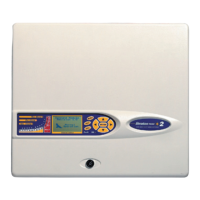Page 9
Stratos HSSD-2 • INSTALLER’S HANDBOOK • Iss. 12
10
6
7
8
9
NB ☞
2.1, Types of display
The Standard Detector display is a two-line LCD which allows basic programming of
the detector.
The Command Module display contains more information than that for the Standard
Detector and prompts the user with the action expected by the use of graphic symbols.
Latching faults
Enter Yes/No:
Yes
Latching faults
Enter Yes/No:
Yes
Press
to change
TEST. When enabled, pressing <TEST> will start a lamp test and then the
detector will show its nominal operating sensitivity as calculated by the
ClassiFire Artificial Intelligence System.
ISOL. Pressing <ISOL> will toggle the unit‘s isolation state. When isolated,
the unit cannot generate any alarms and will signal a fault condition and the
text display will show Panel Isolate. To comply with national standards,
detectors are supplied with the ISOL button disabled as default.
Note: these three buttons can be individually enabled or disabled.
The factory default state of the detector is for only the <TEST>
button to be enabled and for <RESET> and <ISOL> to be disabled.
, , . These buttons, also referred to in the text as menu
buttons or by name, e.g. <ENTER>, are used when programming the unit,
which is pass code protected. See section 3, ‘Programming the unit‘ for
more information.; Pressing
or when not in programming mode
(the access code has NOT been entered) will scroll through the detector’s
event log. See section 7 ‘Event log’ for more information.
Fault. Illuminates when the unit has a fault and a fault signal is being sent to
the fire alarm panel. On the Command Module, this also indicates a fault in
a detector on the communications loop, or in the loop itself.
OK. Illuminates to show normal operation when there are no faults. On the
Command Module this means that the Command Module and all detectors
on the loop are operating normally.

